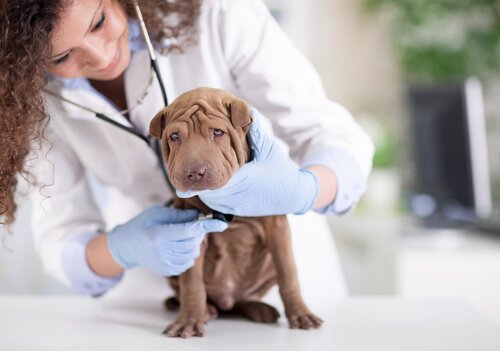Learn How to Detect Anemia in Dogs

In today’s article, we’ll tell you the main signs in order to try to detect anemia in dogs. Knowing the signs that something isn’t right with your dog’s red blood cells will help you detect the condition early, before your dog suffers any serious consequences.
Some facts about anemia
Anemia is defined as the abnormal decrease in the number or size of red blood cells, or one’s level of hemoglobin. Hemoglobin is the red pigment in red blood cells.
Red blood cells are formed in the bone marrow and their function is to transport oxygen from the pulmonary alveoli to other parts of the body. They are also in charge of carrying carbon dioxide to the lungs, where it’s then released.
For this reason, the signs of anemia are a result of the lack of oxygen in the organs and muscles.
Adult dogs are considered anemic when their red blood cell concentration is less than 37% of the volume of their total blood. Normal values range from 39 to 60%.
We’ll tell you the main signs to look out for to detect anemia in dogs. Recognizing these signs will allow you to act quickly so you can avoid any major health complications. So, at the slightest suspicion that your pet is anemic, take him to the vet immediately.
Main signs of anemia in dogs

These are some of the signs that your dog may be anemic:
- Lack of appetite
- Lethargy
- Generalized weakness
- Gum’s mucous membranes and tongue are pale pink, almost white
- Intolerance to exercise
- Getting sick more often
- Pulse and accelerated respiratory rate, in severe cases
If you notice any of these signs in your pet, take him to the vet as soon as possible. The professional will give him blood tests and other complementary studies that will confirm or rule out the diagnosis.
She will also look at the causes of anemia in your dog and determine the appropriate treatment.
Why a dog may become anemic
One of the causes of anemia in dogs is blood loss, which can be caused by:
- Traumas
- Internal and external parasites
- Gastrointestinal tumors
- Ulcers in the stomach or duodenum
A deficit of red blood cell production can also be a result of some eating disorders and some metabolic diseases.
Hemolysis, another cause of anemia in dogs
Hemolysis is another cause of anemia in dogs. This is the acceleration of the normal process of decomposition in red blood cells. A dog with acute hemolysis usually has the following symptoms:
- Jaundice (yellowing of the skin and the whites of their eyes)
- Dark urine
- Inflammation in the spleen, liver and lymphatic glands
However, hemolysis can have different causes:
- Immune-mediated hemolytic anemia (the most common cause). Antibodies destroy the red blood cells (antibodies are directed incorrectly to work against the organs and tissues). This occurs in breeds like Poodles, English Bobtails, Irish Setters and Cocker Spaniels.
- Congenital hemolytic anemia, due to various hereditary abnormalities in the red blood cells’ structure. For example, phosphofructokinase or pyruvate kinase deficiency.
- Reactions to drugs like acetaminophen.
- Serious infections.
- Poisonous snake bites.
If you suspect anemia, go to the vet

If your dog has a severe case of anemia, it’s very likely that he’ll need a blood transfusion. This is just an emergency measure to ensure there aren’t any major complications.
It’s always best to avoid extreme cases. So, pay close attention to your furry friend and, at the slightest suspicion that he may be anemic, take him to the vet.
The faster the vet can determine the causes of his anemia, the more likely the animal will have a speedy recovery. So, show your pet how much you love him by properly taking care of him.
In today’s article, we’ll tell you the main signs in order to try to detect anemia in dogs. Knowing the signs that something isn’t right with your dog’s red blood cells will help you detect the condition early, before your dog suffers any serious consequences.
Some facts about anemia
Anemia is defined as the abnormal decrease in the number or size of red blood cells, or one’s level of hemoglobin. Hemoglobin is the red pigment in red blood cells.
Red blood cells are formed in the bone marrow and their function is to transport oxygen from the pulmonary alveoli to other parts of the body. They are also in charge of carrying carbon dioxide to the lungs, where it’s then released.
For this reason, the signs of anemia are a result of the lack of oxygen in the organs and muscles.
Adult dogs are considered anemic when their red blood cell concentration is less than 37% of the volume of their total blood. Normal values range from 39 to 60%.
We’ll tell you the main signs to look out for to detect anemia in dogs. Recognizing these signs will allow you to act quickly so you can avoid any major health complications. So, at the slightest suspicion that your pet is anemic, take him to the vet immediately.
Main signs of anemia in dogs

These are some of the signs that your dog may be anemic:
- Lack of appetite
- Lethargy
- Generalized weakness
- Gum’s mucous membranes and tongue are pale pink, almost white
- Intolerance to exercise
- Getting sick more often
- Pulse and accelerated respiratory rate, in severe cases
If you notice any of these signs in your pet, take him to the vet as soon as possible. The professional will give him blood tests and other complementary studies that will confirm or rule out the diagnosis.
She will also look at the causes of anemia in your dog and determine the appropriate treatment.
Why a dog may become anemic
One of the causes of anemia in dogs is blood loss, which can be caused by:
- Traumas
- Internal and external parasites
- Gastrointestinal tumors
- Ulcers in the stomach or duodenum
A deficit of red blood cell production can also be a result of some eating disorders and some metabolic diseases.
Hemolysis, another cause of anemia in dogs
Hemolysis is another cause of anemia in dogs. This is the acceleration of the normal process of decomposition in red blood cells. A dog with acute hemolysis usually has the following symptoms:
- Jaundice (yellowing of the skin and the whites of their eyes)
- Dark urine
- Inflammation in the spleen, liver and lymphatic glands
However, hemolysis can have different causes:
- Immune-mediated hemolytic anemia (the most common cause). Antibodies destroy the red blood cells (antibodies are directed incorrectly to work against the organs and tissues). This occurs in breeds like Poodles, English Bobtails, Irish Setters and Cocker Spaniels.
- Congenital hemolytic anemia, due to various hereditary abnormalities in the red blood cells’ structure. For example, phosphofructokinase or pyruvate kinase deficiency.
- Reactions to drugs like acetaminophen.
- Serious infections.
- Poisonous snake bites.
If you suspect anemia, go to the vet

If your dog has a severe case of anemia, it’s very likely that he’ll need a blood transfusion. This is just an emergency measure to ensure there aren’t any major complications.
It’s always best to avoid extreme cases. So, pay close attention to your furry friend and, at the slightest suspicion that he may be anemic, take him to the vet.
The faster the vet can determine the causes of his anemia, the more likely the animal will have a speedy recovery. So, show your pet how much you love him by properly taking care of him.
This text is provided for informational purposes only and does not replace consultation with a professional. If in doubt, consult your specialist.








